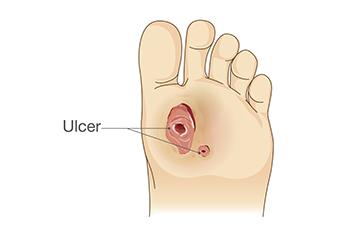Connect With Us
Epifix

What is EpiFix®?
EpiFix® is a human tissue transplant (allograft) derived from dehydrated amniotic membrane. It is used to treat diabetic foot ulcers (DFUs), hard-to-heal wounds, burns and other damaged skin tissue.
EpiFix® retains essential proteins from the donor tissue, acts as a protective barrier for the wound bed, and provides an extracellular matirix—all of which help the body’s healing process work and aid in the development of new tissue.
How EpiFix® Works to Help DFUs Heal
Your podiatrist will typically use standard wound treatment techniques to allow time for your DFU to heal. If it has not begun to heal after 30 days or more and is not infected, your podiatrist may suggest using EpiFix® to help it heal. The process involves:
- Cleaning the ulcer
- Measuring the area to be covered by EpiFix®
- Removing EpiFix® from its sterile packaging using forceps, and cutting it to size
- Applying the EpiFix® to the area
- Re-applying EpiFix® weekly or bi-weekly, or as your podiatrist deems necessary
How EpiFix® Works to Help DFUs Heal
Superior Sterilization Process. EpiFix® goes through the patented PURION process along with additional terminal sterilization—essentially destroying all microorganisms and viruses, with only a one-in-a-million chance of infection.
Faster Healing. Certain studies show that EpiFix® heals wounds faster and with more frequency than other cell-based wound dressings.
Less Cost. Because EpiFix® treatments typically require less applications, the cost is usually less than other types of cell-based wound dressings.
Is EpiFix® Safe?
Yes. The Public Health Service Act has set forth standards which the American Association of Tissue Banks enforces, and EpiFix® must abide by. This includes strict protocols for donor screening, lab testing, and the aforementioned processing and sterilization procedures.
EpiFix® has no adverse side effects and is also safe to use with hyperbaric oxygen therapy and negative pressure wound therapy.
Who is a Good Candidate for EpiFix®?
Your podiatrist will perform a thorough analysis to determine if Epifix® is appropriate for your particular ulcer. Some of the things your podiatrist will take into consideration are:
- Whether your ulcer has not begun to heal after 30 days or more of standard wound treatment
- Whether infection is present
- How long, wide and deep your ulcer is
- Whether there is bone exposure
If you have a diabetic foot ulcer, hard-to-heal wound or burn, talk to your podiatrist about whether EpiFix® is right for you.
